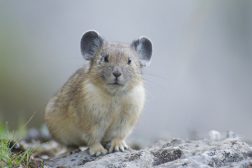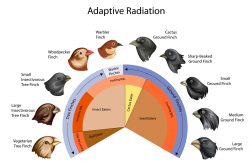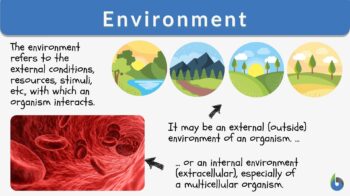
Environment
n., plural: environments
[ɪnˈvaɪɚ(n)mənt]
Definition: The totality of the surrounding conditions and elements in an individual
Table of Contents
Environment Definition
What does environment mean? If you mean physical environment, then it is defined as the surrounding conditions and elements with which a living thing interacts with. However, apart from the physical, there are other types of elements that make up an environment. They are the chemical and biological attributes. Thus, an environment contains all biotic and abiotic factors that have a role in the survival, evolution, and development of the organism occupying it. A related term “environ” is defined as “to surround” or “to enclose”. The scope of the environment varies — from the tiniest, “micro” scale to the largest, global scale.
The terms “ecosystem” and “surroundings” are the common synonyms for the word “environment”. However, they differ in such a way that the term “ecosystem” includes the interaction between the organism and its surroundings. The surroundings, in turn, refer to that which surrounds an organism or a population. In this regard, the environment is a rather vast concept whereas the term “surrounding” is relatively more specific.
Another related term is nature. What’s the difference between environment and nature? Similarly, the definition of nature includes all living and nonliving things on Earth but what characterizes nature is that it is a natural entity as opposed to the artificial that implicates an attribute that is not occurring naturally, and by that it is man-made or “built”.
Different branches of science are interested in studying the environment, its components, and the interaction between living organisms and their environment. For example, environmental science is interested in studying and investigating the interaction of organisms with their environment and its outcomes. A branch of environmental science is ecology, which deals with the ecological interactions within ecosystems.
The environment is the external conditions, resources, stimuli, etc., with which an organism interacts. It may also refer to the external surroundings including all of the biotic and abiotic factors that surround and affect the survival and development of an organism or population, It may also be defined as the totality of the surrounding conditions and elements in an individual.But a simple ecological definition would be is that an environment is essentially the place over a particular time where organisms live or that which is occupied by a living thing. It includes all the physicochemical and biological components of the ecosystem.
Etymology: Middle English “envirounen”, from Old French “environner”, “environ”, meaning “round about” + -“ment”.
Types of Environments
The environment differs from one perspective to another. Let’s take a look at the following ways to group or classify environments.
Internal and external
In physiology, the environment may be internal or external. An internal environment would be the internal milieu of a multicellular organism. Maintaining the internal environment of an organism through homeostasis is crucial to the organism’s survival. An external environment refers to the environment outside of the organism. The next sections focus on the external environment.
Natural and Built
Environments may be natural or built. A natural environment is a type of environment found in nature. It includes all naturally occurring things, both living and nonliving. It, therefore, involves the complex relationships of weather, climate, living species, and natural resources.
Built environments, unlike natural environments, are made by humans, such as agricultural conversions or urban settings. With the current breadth of human interventions and conversions, many natural environments have acquired some degree or level of being “built”.
It is clear that man is a part of the environment; however, the intervention of a man produces a built environment. Humans have developed advanced tools to change components of the environment to meet their needs. Some animal species are also capable of using tools such as raw material to build nests, mounds, dams, and dwellings. However, their tools are relatively primitive and often the impact is not as extensive as that of human tools and technology. Human technology became widely distributed all over the world affecting all aspects of the environment either directly or indirectly.
Aquatic, terrestrial, and atmospheric
Based on the components, the environment may also be classified into (1) aquatic environment (marine, such as oceans and seas, and freshwaters, such as lakes and rivers), (2) terrestrial environment (land), and (3) atmospheric environment (air).
Marine environments are the largest known environments, they are characterized by the presence of water with great salt content. On the other hand, freshwater environments have less salt content. Marine environments represent about 97% of the water on Earth. Organisms within marine environments communicate with each other and with their physical surrounding. These environments are of great importance to humans because it is an important source of nutrition and resources. Marine pollution, acidification, and warming are threats to the marine environment as a result of human activities.
Read: Freshwater Ecology – Biology Online Tutorial

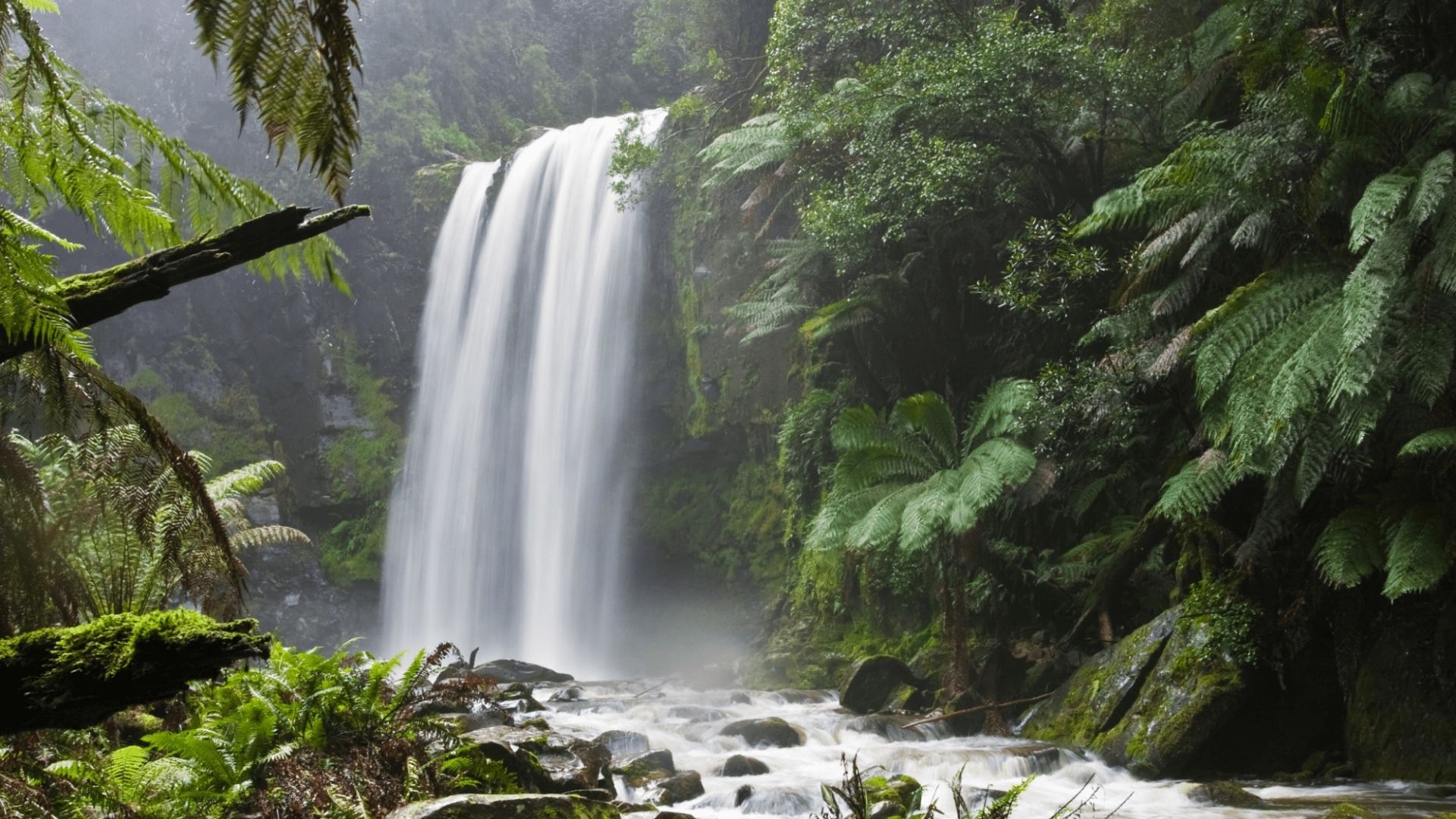
Terrestrial environments are environments found on land only. It represents the land of islands and continents and organisms living on them. Unlike aquatic or marine environments, terrestrial environments are not abundant in water; therefore, the presence of water in terrestrial environments is important. Due to the relatively lower availability of water, the temperature of terrestrial environments fluctuates daily and seasonally. There are six terrestrial ecosystems: taiga, rainforests, temperate forests, tundra, deserts, and grassland.
The atmospheric environment refers to the atmospheric component of an environment. The atmosphere (air) is a part of the Earth that has a huge impact on the thriving and survival of many organisms. Solar radiation, air components, climate, and air pollution are just some of the physicochemical attributes that can define an environment.
Living organisms have adapted to living in a particular environment with its specific conditions, such as humidity, temperature, light, and so on. All these factors affect the species in the environment. Therefore, living organisms have to adapt and modify through time to survive and tolerate different environmental conditions. Nevertheless, the environment itself also ‘evolves’. For example, oxygen eventually became incorporated into the Earth’s atmosphere after being released by photosynthetic organisms (such as algae) when producing sugar as food. Oxygen, eventually, became indispensable to the thriving of aerobic organisms, such as animals, including humans.
External Environment Components
The external environment includes all biotic (living) and abiotic (non-living) things. They are as follows:
Air, land, water
The Earth’s crust is the solid surface of the Earth and is also referred to as the lithosphere. The lithosphere is part of the environment. One natural source of the lithosphere is the solidification of magma.
Water (hydrosphere) is one of the main constituents of the environment. It covers about 71% of the Earth’s surface. It is found in oceans, rivers, seas, and lakes. Oceans cover a great area of the Earth’s surface. They contain saline water in a continuous ocean body and small seas.
Unlike oceans and seas, rivers contain freshwater and they flow toward a sea, a lake, an ocean, or another river. Few rivers flow toward the ground without reaching another water body and dry up. Rivers flow in a channel. They complete the water cycle since the river water is collected from glaciers, recharge of groundwater, and springs. Small rivers are known as streams. They are important in the environment because they connect different habitats and maintain biodiversity.
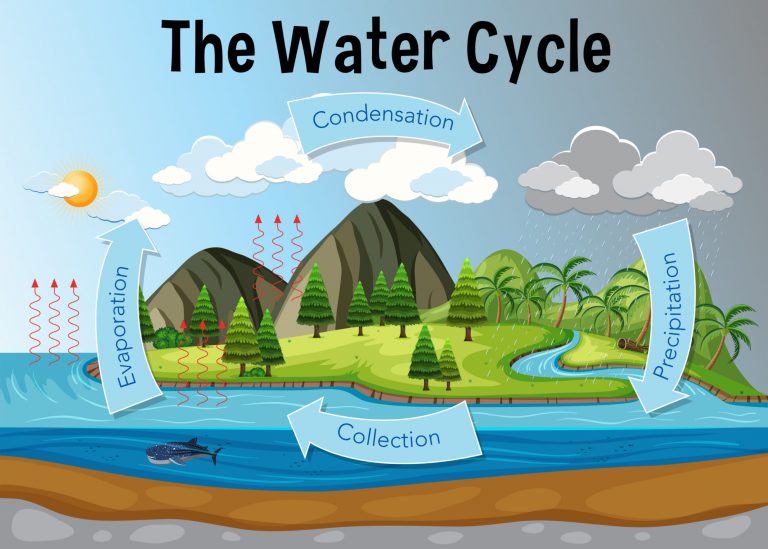
A lake is a body of water in part of the land and not connected to an ocean, the lake is deeper and larger than a pond. Natural lakes are usually present in areas with recent glacier formations or mountain areas. Ponds are small bodies of standing water, they are either naturally formed or man-made, they are smaller than lakes. Man-made ponds include fish ponds and solar ponds.
Water in built environments is affected by humans in various ways such as deforestation, urbanization, building dams, and channels to modify rivers as well as streams. Dams are designed to keep water to keep water and change its direction. Even though dams are useful in generating electricity and creating water reservoirs, they have a negative impact on natural environments by stopping the movement of fish and organisms through rivers and streams. Moreover, they affect the water supplying the forests. This eventually leads to the deterioration of trees and a decrease in the food supply for different biotic factors in the environment.
The atmosphere is the main factor in maintaining the balance of an ecosystem. The atmosphere is composed of a thin layer of gases that covers the Earth. The atmosphere is maintained in its position by the gravitational force. The atmosphere is composed of different gases such as nitrogen, oxygen, carbon dioxide, argon, and inert gases. Moreover, the atmosphere includes water vapor and ice crystals forming clouds. One of the atmosphere layers is the ozone which reduces the intensity of ultraviolet rays reaching the Earth’s surface. Ultraviolet radiation damages the DNA of living organisms. Thus, the atmosphere as a component of the environment is important for the survival of living organisms including humans, and for maintaining the environmental balance by preventing temperature extremes.
Global warming is one of the major challenges affecting our environment nowadays. It refers to the recent increase in the Earth’s average atmospheric temperature due to an increase in the levels of greenhouse gas (e.g., carbon dioxide, methane, ozone, and fluorocarbon). These gases keep the heat within the atmosphere. The rise in their levels in the atmosphere is caused by human activities such as deforestation, carbon dioxide combustion, etc. Because of that, the Earth’s surface temperature became warmer, thus, the name. Global warming is said to increase the average temperature of the Earth’s surface that is enough to cause climatic change. Accordingly, the global surface temperature increased 0.74 ± 0.18 °C (1.33 ± 0.32 °F) during the last century.
The climate is the state of wind, humidity, rain, atmospheric pressure, and temperature in a given area over a long period of time. It is classified in relation to different variables such as precipitation and temperature. Conversely, weather represents the condition of these elements but in the short term only. Both are important components of the environment. Weather is the sum of all phenomena taking place at a given time in a given area. Generally, the weather describes daily temperature values, while the climate describes the average condition of the atmosphere over a long time.
Weather describes differences between places in their moisture and temperature. These differences are due to several factors such as the sun angle on a given area. Surface pressure differs due to differences in temperature from one region to another. Humans developed systems that can predict the future state of the atmosphere, moreover, they tried to control the weather by different methods. There is evidence that activities of humans such as industry and agriculture have modified the weather since it is affected by any small change in the atmosphere.
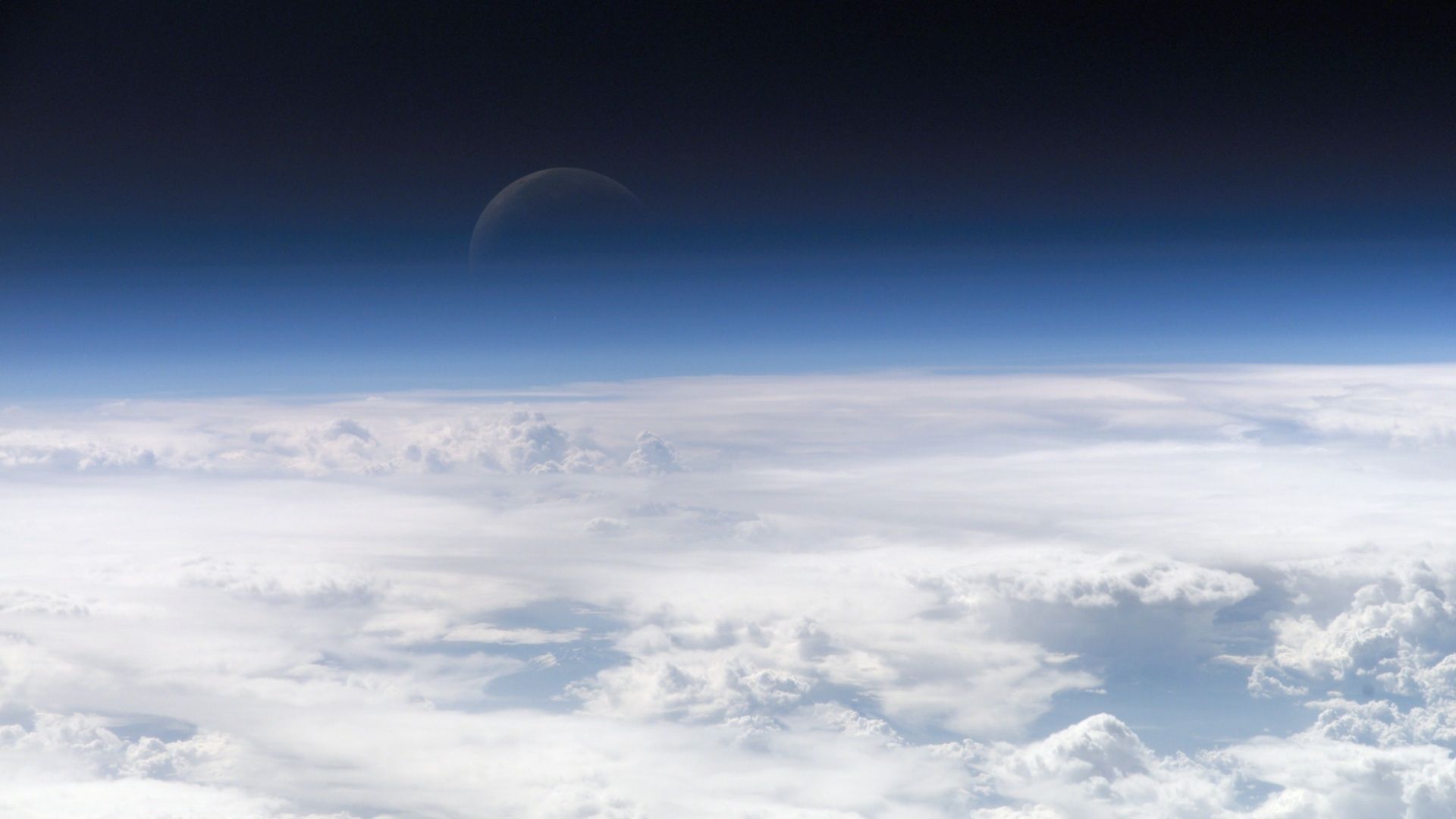
Biosphere
The biotic components represent all living things on Earth, such as bacteria, protists, algae, fungi, plants, and animals. Life existed on Earth for more than 3.7 billion years. It is generally characterized by metabolism, growth, organization, adaptation, response, and reproduction. It includes all living organisms in the environment. The part of the Earth where living organisms occupy is referred to as the biosphere. Different living organisms are found within the biosphere. Living organisms have distinct features and traits that make them adapt to specific environments.
Biomes are ecological communities of different organisms that are able to adapt to the environmental conditions and climate in a certain geographic area; therefore, biomes are large environments characterized by biotic and abiotic factors such as light, temperature, precipitation, and other factors. Biomes are classified into 6 regions, which may either be land or aquatic. Land biomes are grassland, forest, tundra, and desert whereas aquatic biomes are freshwater and marine biomes. Biomes are useful in ecological studies and ecosystem changes as they provide information about the environments and how they change, adapt, evolve, and function.
Ecological Role
The ecosystem is the external environment wherein all organisms function together along with all non-living things in the environment. Living organisms within the ecosystem form complex relationships with abiotic factors in their environment to support their development and survival.
Energy flow
Energy flows between biotic and abiotic parts of the environment in cycles within the system of the ecosystem. Consequently, all components of the ecosystem are integrated with each other in harmony. In the chart below, notice how energy flows in an ecosystem. The energy from the sun (light energy) flows through the various trophic levels (from producers to consumers and decomposers) as it is converted into chemical energy that drives various metabolic activities and ultimately dissipated, e.g. as heat, into the environment.
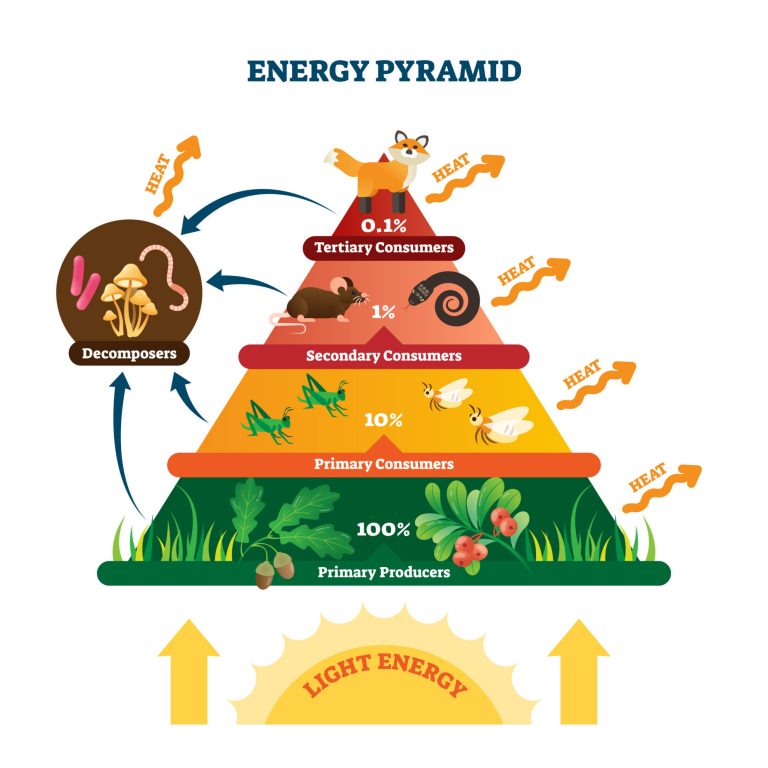
Biogeochemical cycles
Biogeochemical cycles are pathways that allow different chemical substances to move through biotic and abiotic factors on Earth. Biogeochemical cycles are essential for different environments, especially those of carbon, oxygen, nitrogen, phosphorus, and water. For example, the water moves continuously in the water cycle through different parts of the Earth in different forms such as liquid, ice, or vapor in various places. Although water moves continuously in this cycle, its balance remains constant over time. Similarly, the carbon and oxygen cycle maintain the balance of oxygen and carbon on Earth to maintain the life and the atmosphere of Earth.

Challenges
The environment is facing many challenges due to human technologies. Environmentalism is a social movement that aims to eliminate or minimize the harmful effect of humans on the environment. environmentalism is mainly concerned with natural environments and issues they are facing such as the extinction of species, change in climate, loss of old forests, and pollution.
Wildlife is generally the natural environment that has not been affected or modified by man. Wildlife represents regions that are not controlled or developed by human industrial activity. Wilderness areas are mainly used to protect some animal species from extinction, it can also be used in ecological studies and recreation. Wildlife is greatly valued for its environmental, cultural, and spiritual importance.
Because wildlife, uncultivated grassland, unchanged forests, and wildflowers are slowly becoming fewer, the goal of environmentalism is to conserve and protect them. It aims to preserve and protect species, especially those that are at risk of extinction. It also takes effort in maintaining biodiversity in the natural environment. Sustainable and conserved use of water, air, raw material, land, energy, and other natural resources is ideal to help protect the environment. The use of renewable energy to generate electricity, cooling, heating, and in means of transportation instead of using fossil fuel to decrease pollution, minimize global warming, and ensure sustainability is highly encouraged.
Try to answer the quiz below to check what you have learned so far about the environment.
References
- Built Environment. Built Environment – an overview | ScienceDirect Topics. (n.d.). https://www.sciencedirect.com/topics/engineering/built-environment.
- Johnson, D. L., Ambrose, S. H., Bassett, T. J., Bowen, M. L., Crummey, D. E., Isaacson, J. S., … & Winter‐Nelson, A. E. (1997). Meanings of environmental terms. Journal of environmental quality, 26(3), 581-589.
©BiologyOnline.com. Content provided and moderated by Biology Online Editors.


